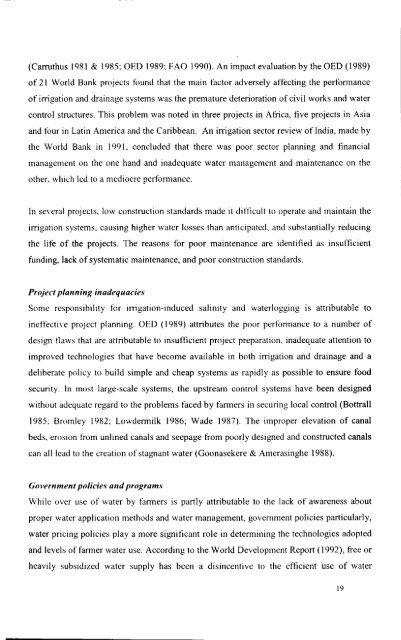Water Users Association and Irrigation Management - Institute for ...
Water Users Association and Irrigation Management - Institute for ...
Water Users Association and Irrigation Management - Institute for ...
Create successful ePaper yourself
Turn your PDF publications into a flip-book with our unique Google optimized e-Paper software.
(Carruthus 1981 & 1985; OED 1989; FAO 1990). An impact evaluation by the OED (1989)<br />
of 21 World Bank projects found that the main factor adversely affecting the per<strong>for</strong>mance<br />
of irrigation <strong>and</strong> drainage systems was the premature deterioration of civil works <strong>and</strong> water<br />
control structures. This problem was noted in three projects in Africa, five projects in Asia<br />
<strong>and</strong> tour in Latin America <strong>and</strong> the Caribbean. An irrigation sector review of India, made by<br />
the World Bank in 1991. concluded that there was poor sector planning <strong>and</strong> financial<br />
management on the one h<strong>and</strong> <strong>and</strong> inadequate water management <strong>and</strong> maintenancc on the<br />
other, which led to a mediocre per<strong>for</strong>mance.<br />
In several projects, low construction st<strong>and</strong>ards made it difticult to operate <strong>and</strong> maintain the<br />
irrigation systems, causing higher water losses than anticipatcd, <strong>and</strong> substantially reducing<br />
the life of the projects. The reasons <strong>for</strong> poor maintenance are identified as insufficient<br />
funding, lack of systematic maintenance, <strong>and</strong> poor construction st<strong>and</strong>ards.<br />
Project planning inadequacies<br />
Some responsibility tor irrigation-induced salinity <strong>and</strong> waterlogging is attributable to<br />
ineffective project planning. OED (1989) attributes the poor per<strong>for</strong>mance to a number of<br />
design tlaws that are attributable to insufticient project preparation, inadequate attention to<br />
improved technologies that have become available in both irrigation <strong>and</strong> drainage <strong>and</strong> a<br />
deliberate policy to build simple <strong>and</strong> cheap systems as rapidly as possible to ensure food<br />
security. In most large-scale systems, the upstream control systems have been designed<br />
without adequate regard to the problems faced by farmers in securing local control (Bottrall<br />
1985: Bromley 1982; Lowdermilk 1986; Wade 1987). The improper elevation of canal<br />
beds. erosion from unlined canals <strong>and</strong> seepage from poorly designed <strong>and</strong> constructed canals<br />
can all lead to the creation of stagnant water (Goonasekere & Amerasinghe 1988).<br />
Government policies <strong>and</strong> programs<br />
While over use of water by farmers is partly attributable to the lack of awareness about<br />
proper water application methods <strong>and</strong> water management, government policies particularly,<br />
water pricing policies playa more signiticant role in determining the technologies adopted<br />
<strong>and</strong> levels of farmer water use. According to the World Development Report (1992), free or<br />
heavily subsidized water supply has been a disincentive to the efficient use of water<br />
19
















